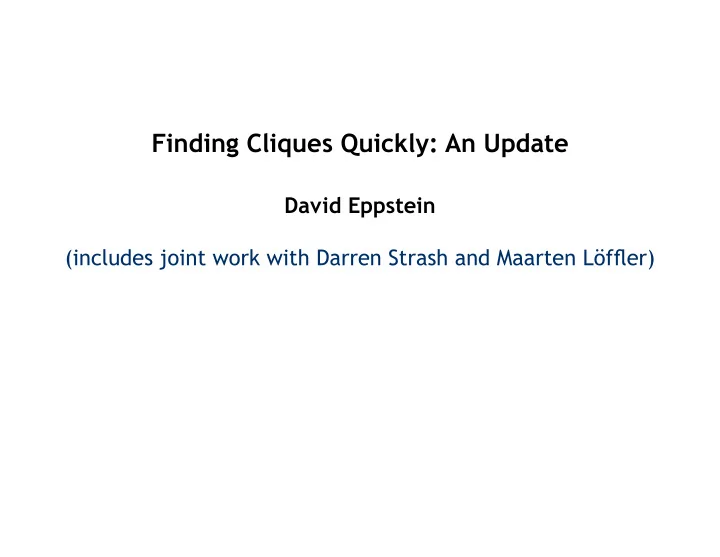

Finding Cliques Quickly: An Update David Eppstein (includes joint work with Darren Strash and Maarten Löffmer)
Clique: subset of vertices in a social network that are all pairwise connected Maximal clique: can’t add any more vertices and retain complete connectivity Finding cliques quickly D. Eppstein, UC Irvine, 2011
A few milestones 1949: Duncan Luce and Albert Perry name the clique problem, and apply it to the problem of fjnding well-connected subsets of people in a social network 1957: Harary and Ross describe the fjrst clique-fjnding algorithm 1965: Moon and Moser show that every n-vertex graph has at most 3 n/3 maximal cliques, and that some graphs have this many 1973: Bron and Kerbosch describe a simple backtracking procedure for listing all maximal cliques that works well in practice ... many more algorithms and papers of lesser importance ... 2006: Tomita, Tanaki, and and Takahashi partially explain the success of the Bron–Kerbosch algorithm by showing its worst case running time exactly matches the Moon–Moser bound Finding cliques quickly D. Eppstein, UC Irvine, 2011
A paradox? The Bron–Kerbosch algorithm has the fastest possible worst-case time bound... ...but this time bound is far too slow to explain its good practicality Finding cliques quickly D. Eppstein, UC Irvine, 2011
Our resolution of the paradox [E, Löffmer, Strash, ISAAC 2010] Instead of using only the number of vertices, use “degeneracy” (minimum d such that every subgraph has a vertex of degree ≤ d) Prove that every graph has at most 3 d/3 n maximal cliques and that some graphs have this many (analogous to Moon–Moser) Find a variant of the Bron–Kerbosch algorithm (based on carefully sequencing the recursive subproblems) whose running time is O(d3 d/3 n), almost optimal Linear for graphs of bounded degeneracy as we expect to be true for many social networks But does our variant work well in practice? Finding cliques quickly D. Eppstein, UC Irvine, 2011
Results for Stanford data sets graph d tomita maxdegree hybrid degen n m road-CA 1,965,206 2,766,607 3 * 2.00 5.34 5.81 road-PA 1,088,092 1,541,898 3 * 1.09 2.95 3.21 road-TX 1,379,917 1,921,660 3 * 1.35 3.72 4.00 amazon 403,394 2,443,408 10 * 3.59 5.01 6.03 email-EuAll 265,214 364,481 37 * 4.93 1.25 1.33 email-Enron 36,692 183,831 43 31.96 2.78 1.30 0.90 web-Google 875,713 4,322,051 44 * 9.01 8.43 9.70 wiki-Vote 7,115 100,762 53 0.96 4.21 2.10 1.14 slashdot 82,168 504,230 55 * 7.81 4.20 2.58 cit-Patents 3,774,768 16,518,947 64 * 28.56 49.22 58.64 Epinions1 75,888 405,740 67 * 27.87 9.24 4.78 wiki-Talk 2,394,385 4,659,565 131 * > 18 , 000 542.28 216.00 berkstan 685,231 6,649,470 201 * 76.90 31.81 20.87
Summary New algorithm is fast... ...faster than the Tomita et al version ...maybe fast enough that our new bounds don’t fully explain its speed Additionally, because it uses signifjcantly less memory than Tomita et al., it can be applied to much larger graphs We presented these experiments at the 2011 Symp. on Experimental Algorithms Our paper was judged to be one of the three best from the symposium, invited to a special issue of J. Experimental Algorithms We intend to make the code available within R so that it can be incorporated into actual social network analysis next phase of research, not yet complete Finding cliques quickly D. Eppstein, UC Irvine, 2011
Recommend
More recommend